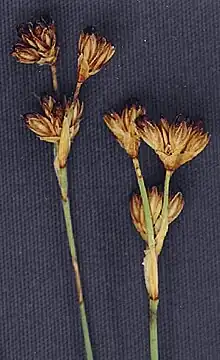Juncus covillei
Juncus covillei is a species of rush known by the common name Coville's rush native to North America.
| Juncus covillei | |
|---|---|
 | |
| Scientific classification | |
| Kingdom: | Plantae |
| Clade: | Tracheophytes |
| Clade: | Angiosperms |
| Clade: | Monocots |
| Clade: | Commelinids |
| Order: | Poales |
| Family: | Juncaceae |
| Genus: | Juncus |
| Species: | J. covillei |
| Binomial name | |
| Juncus covillei | |
Taxonomy
Juncus covillei was first described by Charles Vancouver Piper in Contributions from the United States National Herbarium 11: 182. 1906.[1]
Etymology
Juncus: the generic name was derived from the Latin word jungere meaning "to unite or bind", which comes from the fact that the stems join or intertwine.[2]
colvillei: the species was named in honor of American botanist Frederick Vernon Coville.
Distribution
It is native to western North America from British Columbia to Idaho to California, where it grows in moist habitat, often in forested areas. Including along lakes, rivers and streams, especially on occasionally flooded areas.[3]
Description
This is a perennial herb forming clumps of erect stems up to about 25 centimeters tall from a thick rhizome. The inflorescence is made up of several clusters of brown or green flowers. The flat leaves are blue-green in color. There are 2 to 6 clusters on the plant and 3 to 7 flowers in a cluster. The flowers have six brown tepals. The plump capsules are either equal to or longer than the tepals. 2n equals either 36 or 38.[4] The bloom time is from June to September.[3]
External links
References
- "Tropicos | Name - Juncus covillei Piper". legacy.tropicos.org. Retrieved 2023-09-13.
- "Page J". www.calflora.net. Retrieved 2023-09-13.
- "Lady Bird Johnson Wildflower Center - The University of Texas at Austin". www.wildflower.org. Retrieved 2023-09-13.
- "OregonFlora". oregonflora.org. Retrieved 2023-09-13.
